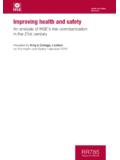Transcription of A study of current working practices for refrigeration ...
1 Prepared by the health and safety Laboratory for the health and safety Executive 2011 health and safety ExecutiveA study of current working practices for refrigeration field service engineersRR839 Research ReportAlan McDonald health and safety LaboratoryHarpur HillBuxtonDerbyshireSK17 9 JNAs a result of a refrigeration related fatality in Stevenage in 2004 HSL has been requested by Stevenage Borough Council under the Local Authority Funding Scheme, to carry out a study of current working practices for refrigeration service engineers.
2 This text focuses primarily on the equipment, practices and procedures employed in order to carry out leak detection and other repair work on refrigeration systems in the field. This definition is further classified as service engineers working on equipment with a refrigerant load of less than 3kg in service on commercial or public premises which may be subject to inspection by local authority inspectors. This report and the work it describes were funded by the health and safety Executive (HSE). Its contents, including any opinions and/or conclusions expressed, are those of the author alone and do not necessarily reflect HSE study of current working practices for refrigeration field service engineersHSE BooksHealth and safety Executive Crown copyright 2011 First published 2011 You may reuse this information (not including logos) free of charge in any format or medium, under the terms of the Open Government Licence.
3 To view the licence visit , write to the Information Policy Team, The National Archives, Kew, London TW9 4DU, or email images and illustrations may not be owned by the Crown so cannot be reproduced without permission of the copyright owner. Enquiries should be sent to ii ACKNOWLEDGEMENTS HSL would like to acknowledge the assistance and cooperation of the Institute of refrigeration technical committee, the Air Conditioning and refrigeration Industry Board, refrigeration Parts Wholesale Ltd, Star refrigeration Ltd, Stevenage Borough Council and City and Guilds in the compilation of this text.
4 This report and the work it describes were funded by the health and safety Executive (HSE). Its contents, including any opinions and/or conclusions expressed, are those of the authors alone and do not necessarily reflect HSE policy. 1 CONTENTS 1 EXECUTIVE 3 2 BACK 4 3 5 4 LEAK 6 5 8 6 DATA 10 7 GAS BOTTLE 11 8 COMMON REPAIR 12 9 EQUIPMENT CHECK 16 10 STANDARDS AND 17 11 INDUSTRY 18 12 19 2
5 1 EXECUTIVE SUMMARY As a result of a refrigeration related fatality in Stevenage in 2004 HSL has been requested by Stevenage Borough Council under the Local Authority Funding Scheme, to carry out a study of current working practices for refrigeration service engineers. This text focuses primarily on the equipment, practices and procedures employed in order to carry out leak detection and other repair work on refrigeration systems in the field. This definition is further classified as service engineers working on equipment with a refrigerant load of less than 3kg in service on commercial or public premises which may be subject to inspection by local authority inspectors.
6 OBJECTIVES To identify and clarify the procedures practices and risks associated with refrigerant leak detection and repair in the field in order to facilitate a better understanding for local authority inspectors by means of the following. Identification of the correct equipment required to carry out the work. Explanation of the procedures and methodology employed. Identification of the legal requirements incumbent upon refrigeration engineers. Clarification of the terminology used in industry guidance and regulatory literature.
7 Identification of the current guidance issued by various industry bodies. Identification of industry bodies including contact information. 3 2 BACK GROUND There have been a number of incidents within the refrigeration service industry in recent years that potentially may have been avoided with improved training or better management.
8 Several of these incidents have occurred whilst refrigeration engineers were carrying out leak detection and or strength testing of refrigeration equipment in the field. The practice of leak testing and system strength testing with an inert gas, most commonly oxygen free dry nitrogen (OFN), has led in some cases to refrigeration systems being unintentionally critically over pressurised. This over pressurisation has then led to explosive failure of the refrigeration system or one of its components resulting in loss of life in some instances and serious injury in others.
9 There have also been incidents resulting in serious injury following the use of incorrect gasses for leak testing and the use of equipment unfit or unsuitable for purpose. The main hazard associated with leak testing and system strength testing during service, repair or commissioning of refrigeration systems is the close proximity to a pressurised system that is required to locate a leak so a repair can be affected. When a refrigeration unit is operating under normal conditions the risk of injury to users, by-standers or engineers is mitigated to a residual level as the system is operating at range of pressures well within its designed range of tolerance.
10 When a refrigeration engineer is carrying out leak detecting with OFN or system strength testing however, the internal pressure of the refrigeration system is entirely under the control of the refrigeration engineer. This places the safety of the engineers and those in the immediate vicinity in the hands of the refrigeration engineer. If the correct equipment is used and the proper procedures are followed the risk of injury is mitigated to an acceptable level. The incidents recorded so far are attributable to human error, inadequate equipment or the use of an incompatible gas.















